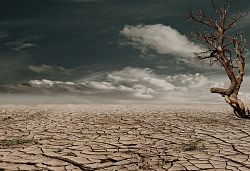

17 June marks the United Nations World Day to Combat Desertification and Drought.
Alongside climate change and biodiversity loss, desertification has been identified as one of the greatest challenges to sustainable development.
In 1994 the United Nations General Assembly established the United Nations Convention to Combat Desertification (UNCCD). This is the sole legally binding international agreement that links environment and development to sustainable land management. As part of this they also made a UN resolution declaring 17 June as World Day to Combat Desertification and Drought.
The theme of this year's day is...
United for Land. Our Legacy. Our Future.
This seeks to spotlight the future of land stewardship — our most precious resource to ensure the stability and prosperity of billions of people around the world, and underscores the critical importance of collective action to preserve our planet's vital land resources for future generations.
Statistics by the UN state that 'Every second, an equivalent of four football fields of healthy land becomes degraded, adding up to a total of 100 million hectares each year'.
Globally, up to 40% of all land areas are already considered degraded.
Not only is ensuring healthy land vitally important for food, but we are also dependent on it for shelter, clothing, jobs and livelihoods. It also is critically important for protecting us from worsening droughts, floods and wildfires.
Sadly unsustainable production and consumption of the earths natural resources, coupled with a growing population are putting excessive pressure on lands that lead to degradation.
Land degradation occurs in may different ways, and has occurred throughout history, however the pace of land degradation is now 30-35 times the historical rate. The major causes of those are climatic variations, which include drought, moisture loss globally, and climate change (which is driven by human activity), and human activities.
Examples of human activities that cause land degradation to occur include:
The damage caused by these activities are then aggravated by wind and water erosion which further strips the topsoil and leaves behind infertile dust and sand and leads to desertification.
Desertification is the long-term result of land degradation whereby once fertile arable land become arid and desert.
The problem is huge as desertification and drought are driving forced migration, putting tens of millions of people at risk of displacement every year.
The UNCCD are taking action to address this critical problem and advocating globally for actions to reduce deforestation and drought. There are many practical actions that can be undertaken to reduce desertification including:
197 countries are party to the UNCCD (a staggering 169 of these are themselves affected by desertification) and they are working together to maintain and restore land. Since 2017, the UNCCD along with their partners have supported around 70 drought prone countries develop national action plans to reduce drought disasters.
So what can you do?
Get involved this World Day to Combat Desertification and Drought and learn more.
The UNCCD have a dedicated website with lots of resources on to learn more about the challenges posed by desertification and drought along with downloadable campaign materials.
For more information visit: https://www.un.org/en/observances/desertification-day
You can also follow the day at #UNited4Land